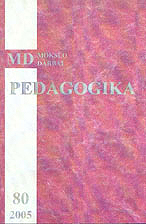Vaiko judesio choreografinė raida ikimokykliniu laikotarpiu
The Choreographic Development of a Child's Movement in Preschool Period
Author(s): Ramutė GaučaitėSubject(s): Education
Published by: Vytauto Didžiojo Universitetas
Keywords: The Choreographic Development of a Child's Movement in Preschool Period
Summary/Abstract: The article reviews the peculiarities of the choreographic development of natural movement in pre-school period. The research tasks were being concretized analyzing the research literature, observing the choreographic activities of 4–7 year old children during the formation experiment, recording the data and interpreting the received research results. The article presents the choreographic movement with its characteristic peculiarities treating it as a consequence of choreographic education, which is based on the child’s topical choreographic activities as a way of expression. This way the choreographic movement records the relations of a child and his environment, in which important role is played by the spirituality of the personality. Treating the child’s activity as a component of his culture and the choreographic improvement of this activity as a precondition and a result of artistic culture education, it has been found that the changing of the movement was also possible only in this total child’s development process. That is why the changing of the movement quality takes place successively, following the presented stages: natural movement, musical movement, movement in the choreographic game, dancing movement, movement in the dance. The experiment that has been carried out has demonstrated that experimental choreographic education has resulted in the change of the movement quality of children in the experimental group: because the results were recorded based on the features, reflecting the quality of choreographic movement and all features changed, it can be stated that the movement of the children in the experimental group has become richer (more graceful) and substantially corresponding to the quality of choreographic movement. This enables to maintain that the choreographic activities, organized during the experimental education, is an effective and suitable way of making the movement aesthetic in pre-school period, whilst the choreographic quality of children’s movement appears as a result of total impact and is a precondition of its education.
Journal: Pedagogika
- Issue Year: 2005
- Issue No: 80
- Page Range: 102-106
- Page Count: 5
- Language: Lithuanian

